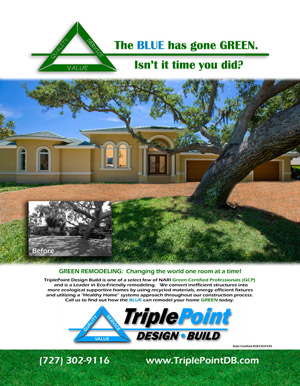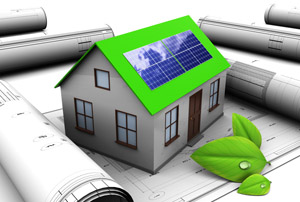So, what makes a house green?

TriplePoint Design Build is one a select few of NARI Green Certified Professionals (GCP) and is a leader in Eco-friendly remodeling. We convert inefficient structures into more ecological supportive homes by using recycled materials, energy efficient fixtures and utilizing a “Healthy Home” systems approach throughout our construction process. Call us today to find out how the Blue can remodel your home Green today.
There are three basic principles applied to green building and green remodeling: energy efficiency, resource conservation, and health. You may already know a lot about energy efficiency. For instance… You want good quality insulated windows that are designed to keep heat inside during the winter and outside during the summer months. Beef up the insulation in the walls and the ceiling to prevent air leaks that waste energy, i.e. weather stripping products.
Examine and repair present heating and cooling system duct work.
Choose energy and water efficient appliances.
Design your rooms to be well illuminated by natural light instead of relying on electricity to it for you.
At the same time choose energy efficient electric lighting and high quality fluorescent lighting.
Provide summer shade. Hot sun striking southern and western exposures makes it difficult to keep your house cool. Plant trees, put in a trellis, install awnings or overhangs to keep the sun off from the windows.


Now, let’s talk about ways to conserve Resources. There are many alternative products available that use natural resources wisely, and sometimes it’s just a matter of using common sense.
A small home uses fewer natural resources to build, furnish or maintain. Keep things simple, and don’t build big if you don’t need to.
Don’t buy every new gadget on the market. They usually end up in a garage sale anyway.
When you’re remodeling, don’t throw things away. Use as much of the existing structure, cabinets, flooring etc. as possible. Donate or recycle what you can’t use.
When buying new items, look for salvaged building materials or choose rapidly renewable resources such as bamboo, cork, and soy. Choose recycled and recyclable products and close the loop by recycling again when you are through with them. Choose good wood with FSC Certification (Forest Stewardship Certification) and buy local products (reduces transportation costs and supports local businesses).
Conserve water by choosing water efficient dishwashers, low flow faucets etc.
Make less waste, and recycle what you can.
Now, let’s consider health. What does green have to do with health? You probably aren’t aware of it, but a lot.


Many commonly used building materials let off noxious fumes (such as formaldehyde).
Indoor contaminants can pollute the house (paint, stains, finishes, glues, molds, mildews and the like).
Watch for existing hazardous materials like lead and asbestos.
Needless to say, adequate air circulation is critical to a healthy home.
As you can see, there are quite a few things to think about when you’re considering remodeling green.
